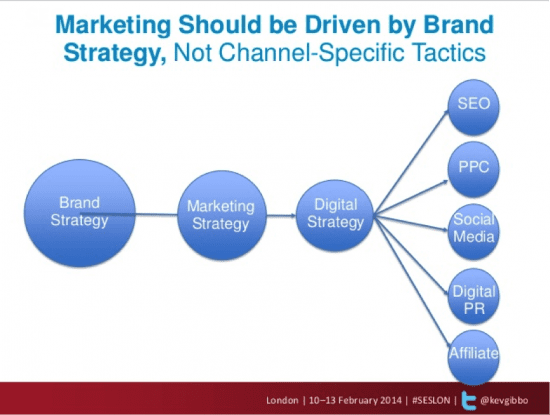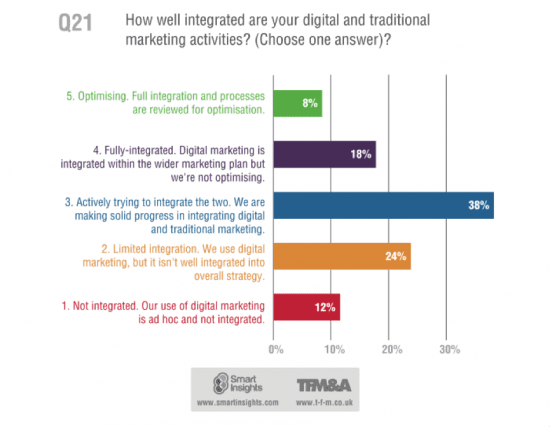3 key barriers that need to be overcome to help towards better integration of digital media
“Truly Integrated Marketing is the holy grail for the marketeer. ”
Colin Green, Marketing Director, Land Rover UK
Yesterday I saw a PPC advert for a pair of shoes that I’d wanted for a while. I clicked through to find that the product was actually out of stock. The next day I was retargeted by the same retailer advertising the same shoes and but at a different price, I clicked through again, and again found that the price was as it was yesterday and there was still no stock. It’s not the first time I have seen this and imagine you may have too. The experience got me thinking about the dangers of running digital marketing in silos leading to a lack of integration with businesses a long-way from the holy grail of integrated marketing communications. In my experience the PPC, retargeting and the merchandising team were all doing the right things:
- PPC – Driving relevant traffic on core product search terms
- Retargeting – Driving personalised repeat visits based on products viewed
- Merchandising – Automatically updating product stock based on availability.
The problem was that they were doing them in isolation and that lead to a poor consumer experience and a probable reduction in sales in both the short and long-term.
Unfortunately that type of experience is all too common.
Research carried out by Smart Insights and TFM&A in 2014 found that 56% of businesses describe their digital marketing capabilities as inconsistent, basic or non-existent, and only 44% had advanced or optimised digital marketing capabilities.
So, it’s safe to say that there are significant opportunities for brands that can integrate effectively. What follows is a short exploration of 3 key digital integration challenges. In future posts, I’ll start to explore each of the 3 problems areas in more depth.
Barrier 1. Lack of planning
“Digital Marketing has to be driven by an overall marketing strategy. In the future, I believe that every marketing activity will involve digital technology.”
Ecommerce Manager
Considered planning helps companies to prioritise, set goals and allocate resources to meet targets, yet the research showed that 46% of businesses with digital outputs don’t have a defined digital plan, and 44% also don’t have a defined marketing plan to align digital strategy against.
As Steve Forbes said “Your brand is the single most important investment you can make in your business.” Your channel strategies should be aligned to this overall strategy to ensure you are delivering a consistent message and experience for your customers.
This is captured nicely in Kevin Gibbons’ graphic:

http://www.slideshare.net/kevgibbo/why-you-need-an-integrated-digital-marketing-strategy
As the graphic shows you may initially need a separate digital plan to help you create a strategy and get buy-in for investment in digital channels. However, it’s important to keep it well integrated by means of supporting common business goals and being consistent with brand and communication strategy. You need to clearly show the linkages between digital and marketing strategy. The long-term aim should be to integrate your digital plan into your marketing communications plan. Please see our Digital Strategy Toolkit for more details on this.
Link to Digital Strategy Toolkit and example marketing plan

Barrier 2. Teams working in competing silos
“In today’s fragmented media world, effective marketing cannot be achieved unless it is integrated.”
Andrew Molle, Marketing Director, Specsavers
There’s a risk that having separate digital and traditional marketing teams can lead to competing priorities and separate team silos. So it’s important to think about how you manage your people integration. Having integrated plans is the first step in this process, breaking down established thought processes, hierarchies and functional barriers within an organisation is the next. Two approaches to solving the silo problem are addressed below.
Brent Gleeson (@brentgleeson) from Internet Marketing Inc suggests the following structure in his article in Forbes.
- Create a unified vision
- Work towards achieving a common goal
- Motivate and incentivise
- Execute and measure
- Collaborate and create
Tanveer Naseer (@TanveerNaseer) from has a number of more practical management tips that that show how digital strategy initiatives can be communicated and silos 'broken down'.
1. Encourage mistakes/failures as opportunities to learn and improve
2. Communicate a common purpose across divisions
3. Redirect the team’s competitive spirit toward external targets
4. Encourage greater flexibility within and between your teams
5. Build trust across your teams/departments
As with all the topics in this post I’m hardly brushing the service but what is clear to me is that integrating your teams, people and processes is just as important as your marketing planning.
Barrier 3. Competing agencies with their own agendas
As marketing budgets are increasingly moved into digital, resourcing the management and optimisation of your internal and external agency teams becomes more important. Agencies, like all business are under pressure to grow their revenues by growing their accounts. In most cases this means taking a larger slice of the pie from other agencies on the roster. It’s no wonder that this leads to a lack of integration between agencies. Just think about how many TV ads you see that don’t have a decent CTA and URL on the end frame!
If we want to integrate our agencies as well as our internal teams and our plans then we need to revaluate how we motivate and reward our agencies. Darren Woolley (@TrinityP3) Managing Director of TrinityP3 points out
“Imagine if rather than having the agencies competing for their increased share of the pie, you reward them for helping to bake a bigger pie? Rather than simply paying for the volume of what goes in, you pay for success in the size of the outcome. Makes sense. Doesn’t it?”
Performance based rewards is nothing new and is used successfully across many industries. Some criteria that should be considered as part of a mixed reward model are:
- Brand, agency relationship
- Working with other agencies
- Strategy development
- Delivery
- Media costs and delivery
- Campaign execution
- ROI or key campaign performance metrics
In a future blog post I will look at reward models and how to find the right balance in more detail.
Where next?
I realise that I’ve covered the peaks of a few icebergs here. I suppose the takeout for me is that while integrating digital seams obvious and simple as an idea, it’s obviously very challenging in the real world mostly due to the processes and systems that we’re all used to. But if we recognise the need for Digital Transformation at a top level and work our way down, we can work to achieving the ‘holy grail’ as Colin Green, Marketing Director of Land Rover UK aptly points out.
Chris Ketley, a digital transformation consultant who has advised businesses including Aviva, Bupa Healthcare, HSBC Business and EDF Energy will be sharing his views on integration and digital transformation at Digital Impact 2014. If you’ve found this blog interesting then please take a look.











